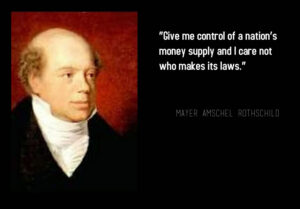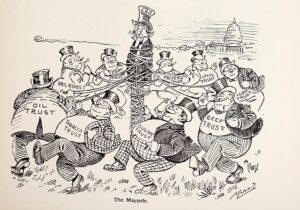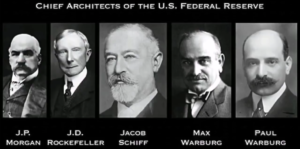Step into the intricate world of New Deal banking reforms and unravel the complex dynamics that unfolded.
Did these legislative maneuvers truly challenge the power of money changers, or did they inadvertently bolster their influence?
In this exploration, we dissect pivotal acts and scrutinize their impact on the elusive figures steering the financial ship.

Unveiling New Deal Banking Realities
Did the new deal banking legislation curtail the power or drive the money changers from the temple?
Contrary to expectations, the New Deal banking legislation not only failed to curtail the power of financial elites but also contributed to their entrenched influence and heightened profits.
The following are but a few examples:
1. The Banking Act of 1933: Navigating Financial Shifts
(a) In a pivotal move, this act mandated that all earnings generated by the Federal Reserve Banks should exclusively benefit the banks themselves.
Before this legislation, the United States Government had a role in the actual distribution of these earnings.
(b) A significant development under this act was the establishment of the Federal Deposit Insurance Corporation.
Despite having a capital of less than $400,000,000, with $150,000,000 subscribed by the Secretary of the Treasury on behalf of the United States Government, this corporation purportedly guarantees around $12 billion of bank deposits.
However, member banks only contribute one-half of one percent of their deposit liabilities to this fund.
Ostensibly aimed at reassuring innocent depositors, it creates a misleading belief that the U.S. Government guarantees deposits up to $5,000 per individual account, masking the actual contribution of $150,000,000 by the Government.
Experienced observers and domestic bankers allege that the true purpose revolves around the exercise of arbitrary examining powers and regulations desired by internationalists.
(c) Another facet of this act is that it designated the debts (bonds) of the United States as the exclusive foundation for issuing private Federal Reserve Notes.
Discover “Money Creators” by Gertrude M. Coogan, an insightful exploration of money creation, its impact on economic stability, and the quest for a more democratic system.
2. The Gold Bill of 1934: Unraveling Illusions

(a) Unveiling a now infamous act, this legislation served as the means by which the Federal Reserve Banks seized all the gold in the United States, stripping citizens of the right to possess gold under penalty.
Despite the deceptive narrative of “nationalizing gold,” the reality is that the gold still belongs to the Federal Reserve Banks, retrievable from the Government upon demand—a glaring sham.
The silver provision within the Gold Bill of 1934 granted the President authority for unlimited coinage of silver, subject to conditions he may prescribe.
However, this initiative failed to establish silver as a primary money base, ultimately harming rather than benefiting the people.
The silver legislation facilitated internationalists in selling silver and receiving payment in gold through the Stabilization Fund.
Purchasers of silver find themselves compensating other nations with Bank of England (privately owned) Bank Notes.
The strategic removal of silver from China, traditionally used as token money for centuries, serves a specific agenda.
This maneuver aims to coerce the Chinese into adopting Bank of England paper notes as the foundation for their currency, aligning with the lofty but misleading propaganda of “tying currencies to sterling.”
Explore “Spiking the Gold or Who Caused the Depression and The Way Out” by Andrae B. Nordskog, revealing the hidden causes of the Great Depression and offering solutions for economic recovery.

3. The Banking Act of 1935: Shifting Powers and Alarming Parallels
(a) Introducing a pivotal shift, this Act allows Federal Reserve Banks to directly loan to industries—a move that positions the bankers’ bank in direct competition with member banks whose funds were invested in the capital stock of Federal Reserve Banks.
(b) Notably, the Act imposes a prohibition on paying interest to demand depositors.
(c) Under this Act, managerial authority is stripped from member banks (owners), transferring control to a board appointed by the President.
Member banks lose their say in policy decisions, compelled to adhere to the directives of the board.
The Open Market operations, extensively discussed in Appendix I, Section I, fall entirely under the purview of the Open Market Committee.
Member banks are mandated to follow the committee’s orders, with the stipulation that “no Federal Reserve Bank shall engage or decline to engage in Open Market operations except in accordance with the direction and regulations adopted by the committee.
” Notably, all paper re-discounted or bought in the Open Market by Federal Reserve Banks must meet the criteria of being both eligible and acceptable.
The term “acceptable” grants Federal Reserve Banks discretionary power to decide which member banks’ paper can be utilized for borrowing from the Central Federal Reserve Banks or which paper (such as private notes of business men and installment purchase notes) will be acquired in the Open Market.
(d) Drawing unsettling parallels with the banking laws enacted in Germany before the tumultuous inflation of the 1920s, this Act raises a critical question: Are we permitting a deliberate destruction akin to historical patterns?
The potential consequences of private money inflation and ensuing chaos could pave the way for Internationalists to establish a dictatorship, consolidating all wealth and power in their hands while subjecting others to economic and social slavery.

Dive into “Money: Questions and Answers” by Charles E. Coughlin for an enlightening exploration of economic principles and financial policies, presented in an accessible Q&A format that makes complex concepts easy to understand and relevant to today’s economic landscape.
Navigating the Currents of New Deal Banking Reforms
As we navigate the convoluted waters of New Deal banking reforms, a stark revelation emerges.
Far from curtailing the power of money changers, these legislative maneuvers inadvertently fortified their influence.
The Banking Act of 1933, a pivotal shift in financial dynamics, steered earnings exclusively to Federal Reserve Banks, diminishing the government’s role in distribution.
The Gold Bill of 1934, under the guise of “nationalizing gold,” surreptitiously granted control to the Federal Reserve Banks, stripping citizens of their gold rights.
The Banking Act of 1935, marked by a pivotal power shift, allowed Federal Reserve Banks to directly compete with member banks, consolidating control in the hands of a board appointed by the President.
In this intricate web of financial transformations, questions arise about the true beneficiaries and the unsettling parallels with historical precedent
